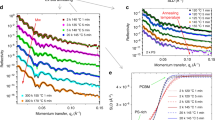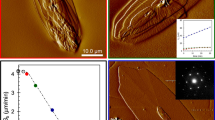Abstract
Spin-coating is a very widely used technique for making uniform thin polymer films. For example, the active layers in most experimental semiconducting polymer-based devices, such as light-emitting diodes and photovoltaics, are made this way. The efficiency of such devices can be improved by using blends of polymers; these phase separate during the spin-coating process, creating the complex morphology that leads to performance improvements. We have used time-resolved small-angle light scattering and light reflectivity during the spin-coating process to study the development of structure directly. Our results provide evidence that a blend of two polymers first undergoes vertical stratification; the interface between the stratified layers then becomes unstable, leading to the final phase-separated thin film. This has given us the basis for establishing a full mechanistic understanding of the development of morphology in thin mixed polymer films, allowing a route to the rational design of processing conditions so as to achieve desirable morphologies by self-assembly.
This is a preview of subscription content, access via your institution
Access options
Subscribe to this journal
Receive 12 print issues and online access
$259.00 per year
only $21.58 per issue
Buy this article
- Purchase on Springer Link
- Instant access to full article PDF
Prices may be subject to local taxes which are calculated during checkout






Similar content being viewed by others
References
Geoghegan, M. et al. Lamellar structure in a thin polymer blend film. Polymer 35, 2019–2027 (1994).
Geoghegan, M. & Krausch, G. Wetting at polymer surfaces and interfaces. Prog. Polym. Sci. 28, 261–302 (2003).
Prosycevas, I., Tamulevicius, S. & Guobiene, A. The surface properties of PS/PMMA blends nanostructured polymeric layers. Thin Solid Films 453, 304–311 (2004).
Dekeyser, C. M., Biltresse, S., Marchand-Brynaert, J., Rouxhet, P. G. & Dupont-Gillain, C. C. Submicrometer-scale heterogeneous surfaces by PS-PMMA demixing. Polymer 45, 2211–2219 (2004).
Li, X., Han, Y. C. & An, L. J. Surface morphology control of immiscible polymer-blend thin films. Polymer 44, 8155–8165 (2003).
Raczkowska, J. et al. Surface patterns in solvent-cast polymer blend films analyzed with an integral-geometry approach. Macromolecules 36, 2419–2427 (2003).
Ton-That, C., Shard, A. G. & Bradley, R. H. Surface feature size of spin cast PS/PMMA blends. Polymer 43, 4973–4977 (2002).
Muller-Buschbaum, P., Gutmann, J. S. & Stamm, M. Control of surface morphology by the interplay between phase separation and dewetting. J. Macromol. Sci.-Phys. B 38, 577–592 (1999).
Ade, H. et al. Phase segregation in polymer thin films: Elucidations by X-ray and scanning force microscopy. Europhys. Lett. 45, 526–532 (1999).
DalnokiVeress, K., Forrest, J. A., Stevens, J. R. & Dutcher, J. R. Physica A 239, 87–94 (1997).
Halls, J. J. M. et al. Efficient photodiodes from interpenetrating polymer networks. Nature 376, 498–500 (1995).
Peumans, P., Uchida, S. & Forrest, S. R. Efficient bulk heterojunction photovoltaic cells using small-molecular-weight organic thin films. Nature 425, 158–162 (2003).
Morteani, A. C. et al. Barrier-free electron-hole capture in polymer blend heterojunction light-emitting diodes. Adv. Mater. 15, 1708–1712 (2003).
Snaith, H. J. & Friend, R. H. Morphological dependence of charge generation and transport in blended polyfluorene photovoltaic devices. Thin Solid Films 451, 567–571 (2004).
Moons, E. Conjugated polymer blends: linking film morphology to performance of light emitting diodes and photodiodes. J. Phys. C 14, 12235–12260 (2002).
Granstrom, M. et al. Laminated fabrication of polymeric photovoltaic diodes. Nature 395, 257–260 (1998).
Kim, J. S., Ho, P. K. H., Murphy, C. E. & Friend, R. H. Phase separation in polyfluorene-based conjugated polymer blends: Lateral and vertical analysis of blend spin-cast thin films. Macromolecules 37, 2861–2871 (2004).
Chappell, J. et al. Correlating structure with fluorescence emission in phase-separated conjugated-polymer blends. Nature Mater. 2, 616–621 (2003).
Corcoran, N., Arias, A. C., Kim, J. S., MacKenzie, J. D. & Friend, R. H. Increased efficiency in vertically segregated thin-film conjugated polymer blends for light-emitting diodes. Appl. Phys. Lett. 82, 299–301 (2003).
Arias, A. C. et al. Vertically segregated polymer-blend photovoltaic thin-film structures through surface-mediated solution processing. Appl. Phys. Lett. 80, 1695–1697 (2002).
Boltau, M., Walheim, S., Mlynek, J., Krausch, G. & Steiner, U. Surface-induced structure formation of polymer blends on patterned substrates. Nature 391, 877–879 (1998).
Walheim, S., Boltau, M., Mlynek, J., Krausch, G. & Steiner, U. Structure formation via polymer demixing in spin-cast films. Macromolecules 30, 4995–5003 (1997).
Jukes, P. C., Heriot, S. Y., Sharp, J. S. & Jones, R. A. L. Time-resolved light scattering studies of phase separation in thin film semiconducting polymer blends during spin-coating. Macromolecules 38, 2030–2032 (2005).
Cahn, J. W. Phase separation by spinodal decomposition in isotropic systems. J. Chem. Phys. 42, 93–99 (1965).
Sferrazza, M. et al. Interfacial instability driven by dispersive forces: The early stages of spinodal dewetting of a thin polymer film on a polymer substrate. Phys. Rev. Lett. 81, 5173–5176 (1998).
Reiter, G. Dewetting of thin polymer-films. Phys. Rev. Lett. 68, 75–78 (1992).
Nevot, L. & Croce, P. Caractérisation des surfaces par réflexion rasant de rayons x: application á l’étude du polissage de quelques verres silicates. Rev. Phys. Appl. 15, 761–779 (1980).
Brochard-Wyart, F., Martin, P. & Redon, C. Liquid/liquid dewetting. Langmuir 9, 3682–3690 (1993).
de Gennes, P. G. Instabilities during the evaporation of a film: Non-glassy polymer plus volatile solvent. Eur. Phys. J. E 6, 421–424 (2001).
Broseta, D., Leibler, L., Kaddour, L. O. & Strazielle, C. A theoretical and experimental study of interfacial-tension of immiscible polymer blends in solution. J. Chem. Phys. 87, 7248–7256 (1987).
Bernasik, A. et al. Lamellar structures formed in spin-cast blends of insulating and conducting polymers. Synth. Met. 144, 253–257 (2004).
Routh, A. F. & Russel, W. B. A process model for latex film formation: Limiting regimes for individual driving forces. Langmuir 15, 7762–7773 (1999).
Acknowledgements
We would like to thank S. Martin and M. Geoghegan for helpful discussions and EPSRC for financial support.
Author information
Authors and Affiliations
Corresponding author
Ethics declarations
Competing interests
The authors declare no competing financial interests.
Supplementary information
Supplementary Information
Supplementary figures S1-S7 (PDF 469 kb)
Supplementary Movie
Supplementary movie S2 (AVI 1544 kb)
Rights and permissions
About this article
Cite this article
Heriot, S., Jones, R. An interfacial instability in a transient wetting layer leads to lateral phase separation in thin spin-cast polymer-blend films. Nature Mater 4, 782–786 (2005). https://doi.org/10.1038/nmat1476
Received:
Accepted:
Published:
Issue Date:
DOI: https://doi.org/10.1038/nmat1476
This article is cited by
-
A materials physics perspective on structure–processing–function relations in blends of organic semiconductors
Nature Reviews Materials (2023)
-
Non-destructive depth-dependent morphological characterization of ferroelectric:semiconducting polymer blend films
Colloid and Polymer Science (2021)
-
Robust rapid-setting antibacterial liquid bandages
Scientific Reports (2020)
-
Solvo-selective imprinting of a thin polymer blend film for creating multi-length scale patterns
Bulletin of Materials Science (2020)
-
High Performance of Cost-Effective Low-E Coating on Flexible PET Substrate with Transparent Amorphous Oxide Semiconductor
Transactions on Electrical and Electronic Materials (2019)



